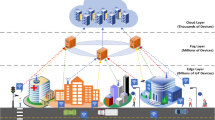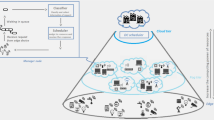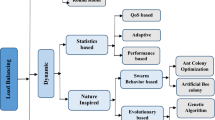Abstract
With the rapid increase in the functionality of IoT applications, the services provided by edge/IoT devices have surged in the recent past. Fog computing is gaining momentum as a contemporary computational framework for IoT-enabled smart applications that offers a latency sensitivity advantage over cloud computing. Effective task scheduling reduces application computation and latency durations while improves QoS. Many researchers have proposed a variety of heuristic and metaheuristic approaches for effective scheduling; however, there is still scope for improvement. The present work proposes a hybrid of heuristic and metaheuristic techniques for the scheduling of tasks. fireworks algorithm (FWA) is a metaheuristic algorithm, and Heterogeneous Earliest Finish Time (HEFT) is a heuristic algorithm. The bi-objective optimization approach is presented to minimize the makespan and cost factors. To compare the performance of the algorithm, the experiments have been conducted on distinct and independent scientific workflows. The results of exhaustive simulations have established the significance of the presented BH-FWA algorithm over other comparative approaches. To validate the relevance of the technique for fog computing networks, the metrics utilized for comparisons are makespan, cost, and throughput.










Similar content being viewed by others
References
The Internet of Things—A movement not a market | IHS Markit. https://ihsmarkit.com/Info/1017/internet-of-things.html
Yi S, Li C, Li Q (2015) A survey of fog computing: Concepts, applications and issues. In: Proceedings of the International Symposium on Mobile Ad Hoc Networking and Computing (MobiHoc). Association for Computing Machinery, New York, NY, USA, pp 37–42
Gao H, Huang W, Yang X et al (2018) Toward service selection for workflow reconfiguration: an interface-based computing solution. Futur Gener Comput Syst 87:298–311. https://doi.org/10.1016/j.future.2018.04.064
Liu CY, Zou CM, Wu P (2014) A task scheduling algorithm based on genetic algorithm and ant colony optimization in cloud computing. In: Proceedings - 13th International Symposium on Distributed Computing and Applications to Business, Engineering and Science, DCABES 2014. Institute of Electrical and Electronics Engineers Inc., pp 68–72
Xu J, Lam AYS, Li VOK (2011) Chemical reaction optimization for task scheduling in grid computing. IEEE Trans Parallel Distrib Syst 22:1624–1631. https://doi.org/10.1109/TPDS.2011.35
Zhang N, Yang X, Zhang M et al (2018) A genetic algorithm-based task scheduling for cloud resource crowd-funding model. Int J Commun Syst 31:e3394. https://doi.org/10.1002/dac.3394
Attiya G, Hamam Y (2006) Task allocation for maximizing reliability of distributed systems: a simulated annealing approach. J Parallel Distrib Comput 66:1259–1266. https://doi.org/10.1016/j.jpdc.2006.06.006
Tan Y, Tan Y (2015) Fireworks Algorithm (FWA). Fireworks Algorithm. Springer, Berlin Heidelberg, pp 17–35
Bacanin N, Tuba M (2015) Fireworks algorithm applied to constrained portfolio optimization problem. In: 2015 IEEE Congress on Evolutionary Computation, CEC 2015 - Proceedings. Institute of Electrical and Electronics Engineers Inc., pp 1242–1249
Zheng S, Tan Y (2013) A unified distance measure scheme for orientation coding in identification. In: 2013 IEEE 3rd International Conference on Information Science and Technology, ICIST 2013. IEEE Computer Society, pp 979–985
Pholdee N, Bureerat S (2014) Comparative performance of meta-heuristic algorithms for mass minimisation of trusses with dynamic constraints. Adv Eng Softw 75:1–13. https://doi.org/10.1016/j.advengsoft.2014.04.005
Xue J, Xiao J, Zhu J (2019) Binary Fireworks Algorithm for 0–1 Knapsack Problem. In: Proceedings - 2019 International Conference on Artificial Intelligence and Advanced Manufacturing, AIAM 2019. Institute of Electrical and Electronics Engineers Inc., pp 218–222
Guzek M, Bouvry P, Talbi EG (2015) A survey of evolutionary computation for resource management of processing in cloud computing [review article]. IEEE Comput Intell Mag 10:53–67
Souza VB, Masip-Bruin X, Marín-Tordera E et al (2018) Towards a proper service placement in combined Fog-to-Cloud (F2C) architectures. Futur Gener Comput Syst 87:1–15. https://doi.org/10.1016/J.FUTURE.2018.04.042
Naha RK, Garg S, Georgakopoulos D et al (2018) Fog computing: Survey of trends, architectures, requirements, and research directions. IEEE Access 6:47980–48009. https://doi.org/10.1109/ACCESS.2018.2866491
Bitam S, Zeadally S, Mellouk A (2018) Fog computing job scheduling optimization based on bees swarm. Enterp Inf Syst 12:373–397. https://doi.org/10.1080/17517575.2017.1304579
Binh HTT, Anh TT, Son DB, et al (2018) An evolutionary algorithm for solving task scheduling problem in cloud-fog computing environment. In: ACM International Conference Proceeding Series. Association for Computing Machinery, New York, New York, USA, pp 397–404
Skarlat O, Nardelli M, Schulte S et al (2017) Optimized IoT service placement in the fog. Serv Oriented Comput Appl 11:427–443. https://doi.org/10.1007/s11761-017-0219-8
Potu N, Jatoth C, Parvataneni P (2021) Optimizing resource scheduling based on extended particle swarm optimization in fog computing environments. Concurrency Computat Pract Exper. 6163:1–13. https://doi.org/10.1002/cpe.6163
Yadav V, Natesha B V., Guddeti RMR (2019) GA-PSO: Service Allocation in Fog Computing Environment Using Hybrid Bio-Inspired Algorithm. In: IEEE Region 10 Annual International Conference, Proceedings/TENCON. IEEE, pp 1280–1285
Li J, Tian Q, Zhang G et al (2018) Task scheduling algorithm based on fireworks algorithm. EURASIP J Wirel Commun Netw 2018:256. https://doi.org/10.1186/s13638-018-1259-2
Wang S, Zhao T, Pang S (2020) Task Scheduling Algorithm Based on Improved Firework Algorithm in Fog Computing. IEEE Access 8:32385–32394. https://doi.org/10.1109/ACCESS.2020.2973758
Reddy KS, Kumar Panwar L, Kumar R, Panigrahi BK (2016) Distributed resource scheduling in smart grid with electric vehicle deployment using fireworks algorithm. J Mod Power Syst Clean Energy 4:188–199. https://doi.org/10.1007/s40565-016-0195-6
Ye S, Ma H, Xu S et al (2017) An effective fireworks algorithm for warehouse-scheduling problem. Trans Inst Meas Control 39:75–85. https://doi.org/10.1177/0142331215600047
Fan Q, Ansari N (2019) On cost aware cloudlet placement for mobile edge computing. IEEE/CAA J Autom Sin 6:926–937. https://doi.org/10.1109/JAS.2019.1911564
Zhang PY, Zhou MC (2018) Dynamic cloud task scheduling based on a two-stage strategy. IEEE Trans Autom Sci Eng 15:772–783. https://doi.org/10.1109/TASE.2017.2693688
Li L, Guan Q, Jin L, Guo M (2019) Resource allocation and task offloading for heterogeneous real-time tasks with uncertain duration time in a fog queueing system. IEEE Access 7:9912–9925. https://doi.org/10.1109/ACCESS.2019.2891130
Singh SP, Nayyar A, Kaur H, Singla A (2019) Dynamic task scheduling using balanced VM allocation policy for fog computing platforms. Scalable Comput 20:433–457. https://doi.org/10.12694/scpe.v20i2.1538
Stojmenovic I, Wen S (2014) The Fog computing paradigm: Scenarios and security issues. In: 2014 Federated Conference on Computer Science and Information Systems, FedCSIS 2014. Institute of Electrical and Electronics Engineers Inc., pp 1–8
Hu P, Ning H, Qiu T et al (2017) Fog computing based face identification and resolution scheme in internet of things. IEEE Trans Ind Informatics 13:1910–1920. https://doi.org/10.1109/TII.2016.2607178
Pham XQ, Huh EN (2016) Towards task scheduling in a cloud-fog computing system. In: 18th Asia-Pacific Network Operations and Management Symposium, APNOMS 2016: Management of Softwarized Infrastructure - Proceedings. Institute of Electrical and Electronics Engineers Inc., pp 1–4
Yu J, Buyya R (2006) Scheduling scientific workflow applications with deadline and budget constraints using genetic algorithms. Sci Program 14:217–230. https://doi.org/10.1155/2006/271608
Schad J, Dittrich J, Quiané-Ruiz JA (2010) Runtime measurements in the cloud: observing, analyzing, and reducing variance. Proc VLDB Endow 3:460–471. https://doi.org/10.14778/1920841.1920902
Su S, Li J, Huang Q et al (2013) Cost-efficient task scheduling for executing large programs in the cloud. Parallel Comput 39:177–188. https://doi.org/10.1016/j.parco.2013.03.002
Yadav AM, Sharma SC, Tripathi KN (2020) A two-step technique for effective scheduling in cloud-fog computing paradigm. Adv Intell Syst Comput 1086:367–379. https://doi.org/10.1007/978-981-15-1275-9_30
Topcuoglu H, Hariri S, Wu MY (2002) Performance-effective and low-complexity task scheduling for heterogeneous computing. IEEE Trans Parallel Distrib Syst 13:260–274. https://doi.org/10.1109/71.993206
Zheng YJ, Xu XL, Ling HF, Chen SY (2015) A hybrid fireworks optimization method with differential evolution operators. Neurocomputing 148:75–82. https://doi.org/10.1016/j.neucom.2012.08.075
Tan Y, Zhu Y (2010) Fireworks algorithm for optimization. Lecture Notes in Computer Science (including subseries Lecture Notes in Artificial Intelligence and Lecture Notes in Bioinformatics). Springer, Berlin, Heidelberg, pp 355–364
Chen S, Liu Y, Wei L, Guan B (2018) PS-FW: a hybrid algorithm based on particle swarm and fireworks for global optimization. Comput Intell Neurosci. https://doi.org/10.1155/2018/6094685
Li J, Tan Y (2018) The bare bones fireworks algorithm: a minimalist global optimizer. Appl Soft Comput J 62:454–462. https://doi.org/10.1016/j.asoc.2017.10.046
Gupta H, Vahid Dastjerdi A, Ghosh SK, Buyya R (2017) iFogSim: a toolkit for modeling and simulation of resource management techniques in the internet of things, edge and fog computing environments. Softw Pract Exp 47:1275–1296. https://doi.org/10.1002/spe.2509
Deelman E, Vahi K, Juve G et al (2015) Pegasus, a workflow management system for science automation. Futur Gener Comput Syst 46:17–35. https://doi.org/10.1016/j.future.2014.10.008
Dubey K, Shams MY, Sharma SC et al (2019) A management system for servicing multi-organizations on community cloud model in secure cloud environment. IEEE Access 7:159535–159546. https://doi.org/10.1109/ACCESS.2019.2950110
Moses J, Iyer R, Illikkal R, et al (2011) Shared resource monitoring and throughput optimization in cloud-computing datacenters. In: Proceedings—25th IEEE International Parallel and Distributed Processing Symposium, IPDPS 2011. pp 1024–1033
Tripathi KN, Yadav AM, Sharma SC (2020) DOSP: Data Dissemination with Optimized and Secured Path for Ad-hoc Vehicular Communication Networks. In: IEEE 17th International Conference on Mobile Ad Hoc and Sensor Systems (MASS). IEEE, pp 121–128
Author information
Authors and Affiliations
Corresponding author
Additional information
Publisher's Note
Springer Nature remains neutral with regard to jurisdictional claims in published maps and institutional affiliations.
Rights and permissions
About this article
Cite this article
Yadav, A.M., Tripathi, K.N. & Sharma, S.C. A bi-objective task scheduling approach in fog computing using hybrid fireworks algorithm. J Supercomput 78, 4236–4260 (2022). https://doi.org/10.1007/s11227-021-04018-6
Accepted:
Published:
Issue Date:
DOI: https://doi.org/10.1007/s11227-021-04018-6




